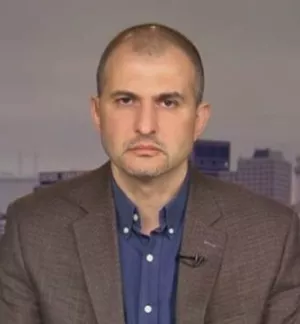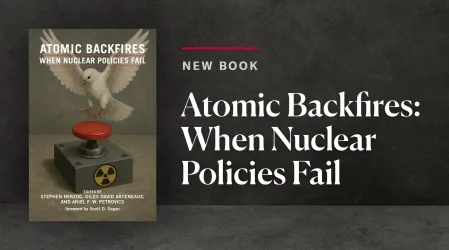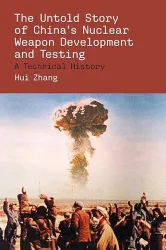U.S. and Russia should infer lessons from their joint exploration of space to revive their nuclear security cooperation.
Without Korolev, Russia, Houston would have had a problem. This Moscow region city, named after the father of the Soviet space program, produces capsules that are now the only way NASA can transport its astronauts to space and back. America also remains dependent on Russia for engines to power rockets that launch U.S. government payloads—including satellites that spy on Moscow. Russia, too, depends on the U.S.: Its spacecraft and rocket makers earn billions of dollars launching American astronauts and cargo into space, while Russia’s strategic aviation—part of the force meant to deter America—reportedly used signals beamed by U.S. GPS satellites even after relations between the two countries began to deteriorate in 2012.
This interdependence between the U.S. and Russian space programs persists despite the fact that the two countries are now living through what some pundits describe as a new Cold War. However, there was a time not so long ago when the two nations viewed space solely as an area of strategic competition. The steps that Washington and Moscow took to transform their space rivalry into cooperation can serve today as a model for working together to help prevent nuclear terrorism, no matter how strained relations may seem.
To put the story in context: In 1960, U.S. presidential candidate John F. Kennedy ran on a platform that promised to usher in American superiority over the Soviet Union in space exploration and to close the strategic ballistic missile “gap.” Shocked in 1961 by the Soviet success in launching the first man into space, Kennedy committed his country to putting a man on the moon before the decade was out.
Manned space flight became emblematic of U.S.-Russian competition, with each country sacrificing blood and treasure to beat the other. Space flight involved the most advanced technologies and sensitive secrets of the time. Bilateral cooperation was unthinkable. Yet, by summer 1975, the two countries had launched their joint Apollo-Soyuz mission. Today, as noted above, the two space programs are not just cooperative but interdependent, although the United States is developing alternatives.
While continuing to work together in exploring the cosmos, the United States and Russia have all but ended cooperation in a sphere where a failure to work together could lead to catastrophe not only for the two countries but globally. Reacting to Russia’s use of force in Ukraine, the Obama administration restricted nuclear energy and technology cooperation between the two countries. Russia responded by effectively ending a range of projects aimed at improving nuclear security. Russian Deputy Foreign Minister Sergei Ryabkov called the measures a response to Washington's "hostile" move to freeze nuclear-energy cooperation. Such rollback is all the more regrettable given that top statesmen on both sides have described nuclear terrorism as one of the greatest threats to their respective countries and humanity as a whole.
The success of the U.S.-Russian cooperation in space shows that there are four concrete steps the United States and Russia can take to re-establish their partnership to prevent nuclear terrorism by improving the security of fissile materials:
- Set mutually agreed goals: The United States and post-Communist Russia could not have achieved great strides in their cooperation in manned space exploration if they didn’t agree about their common goal—the International Space Station (ISS). If Moscow and Washington had not agreed to drop their separate space station programs—America’s planned Freedom and Russia’s aging Mir—in favor of co-leading a multi-nation effort to build an international station, Americans would not be riding to space on Russian rockets and Russians would not have supplied fuel for American inter-planetary probes. Following the example set in space, the United States and Russia could seek to use templates deployed for effective nuclear security as an example to be discussed with other nuclear-capable states.
- Agree to pursue these goals in a partnership of equals: U.S.-Russian space cooperation would not have become so comprehensive and mutually beneficial if Washington had not treated Moscow as an equal partner in that endeavor despite the fact that post-Communist Russia was no match for the U.S. economically, militarily and demographically. Likewise, U.S.-Russian cooperation in the nuclear-security sphere cannot be revived unless it is based on a foundation of equality appropriate to both countries’ deep experience in nuclear matters.
- Designate agencies and leaders responsible for advancing this partnership: As noted above, examples of successful U.S.-Russian space cooperation date back to 1975 when the two nations were still locked in Cold War rivalry. Then NASA had no counterpart in Russia with which to work. The Soviet Ministry of Defense and Ministry of General Machine-Building, which together ran the nation’s space effort, sought to hide their roles in the program. Moscow designated the completely separate Soviet Academy of Sciences Institute of Space Studies as the public proxy to represent the Soviet side on the Apollo–Soyuz project. A major advance in post-Cold War space cooperation between Washington and Moscow was the establishment of the Russian Space Agency in April 1992, as it provided NASA with a direct, single, authorized counterpart, greatly facilitating cooperation and leading to the U.S.-Russian Space Cooperation Agreement later that year. The United States and Russia should designate lead agencies in nuclear-security cooperation as well as revive the Nuclear Security Working Group that functioned as part of the U.S.-Russian bilateral presidential commission until then-President Barack Obama suspended it over the conflict in Ukraine. The designation of responsible senior-level officials with specific goals and deadlines also helped along the Bratislava Initiative by presidents George W. Bush and Vladimir Putin, which increased the pace and scope of nuclear-security work in Russia. The revived working group could focus on coordinating research, development and deployment of new technologies to improve nuclear security and on sharing information about threats to nuclear security. It could also work to establish empirically based standards for effective nuclear-weapons and materials security and for discussion with other nuclear-weapons states.
- Ensure that cooperation yields tangible benefits: One of the factors that drove the U.S. and Russia to cooperate in space was money. Both sides found it profitable to coordinate their space programs and share costs. NASA has estimated it would have cost more than $2 billion a year to continue flying Shuttles beyond 2010 at an annual rate of three flights until a new U.S. orbiter became operational. And the benefits from cooperation are not just financial. In a 2008 op-ed, NASA Administrator Michael Griffin wrote that using Russian spacecraft would probably save lives. If NASA had continued to fly Shuttles instead of sending astronauts to the ISS in Russian-made Soyuz-TMAs, the chances of losing astronauts would have increased from about 1 in 80 to 1 in 8, according to Griffin. (In the end it was a Soyuz-TMA that took astronaut Jeff Williams to space in 2016 allowing him to break the record for most cumulative time spent in space by an American.)
The Russian side also benefited from cooperation. When Russia’s economic woes made it impossible to adequately fund its space budgets, U.S. money helped the Russian space agency to maintain its Mir space station and, later in the 1990s, to build modules for Mir’s successor, the ISS. Russia has made billions of dollars constructing components for the ISS and launching U.S. satellites and astronauts into space. Most recently, NASA transferred more than $370 million to Boeing so the U.S. company could buy seats on board Russian Soyuz-TMAs to fly five more U.S. astronauts to the ISS. Likewise, U.S. and Russian cooperation on nuclear security could generate profits for both sides. More important, such cooperation would diminish the risk of successful nuclear terrorism attacks—an immensely greater benefit.
To be sure, such cooperation would necessarily involve the protection of sensitive technologies. But the two sides have managed to do this before, in their space cooperation.
Of the above four steps, equality and benefits are necessary (though not sufficient) conditions for successful cooperation. One way to encourage their emergence would be for U.S. and Russian entities to pursue joint research and development of nuclear-security hardware and concepts of operation for application in third countries, as well as domestically. The United States and Russia could then both manufacture equipment based on the intellectual property they have jointly developed. Scientists in both countries are best positioned to define the realms of work that would be most useful, but a few examples seem to be worth considering:
On the Russian side:
- Technology for detecting explosives (NATO was previously cooperating with Russia in this area);
- Robots to guard security perimeters;
- Vehicles designed for defending nuclear installations, conducting reconnaissance and fighting saboteurs.
On the U.S. side:
- “Physical cryptography” for secure and accurate accounting of the world's nuclear arsenals.
- New nuclear-material detectors that operate with greater accuracy and at a lower cost, especially in distinguishing different types of material.
Of course, the relatively small nuclear-security market won’t generate the same scale of profits for either side as the space market, but if cooperation in third countries succeeds, it would generate additional revenues, enable U.S. and Russian entities to use the products of their joint research to improve security in their own countries and renew opportunities for U.S.-Russian collaboration to enhance each other’s nuclear security.
Russia and the United States continue to have real and important differences over national security issues. That, however, does not mean the two countries should not and cannot cooperate on matters where joint efforts can greatly enhance the security of both countries. Improving nuclear security is one such sphere and the Trump administration—which has sought to improve relations with Russia—should seize upon it both as a means to achieve closer cooperation with Moscow and as a benefit to gain from such ties.
This is an expanded version of the article by Simon Saradzhyan and William Tobey that appeared in the Bulletin of Atomic Scientists on March 7, 2017.
"Applying Lessons of U.S.-Russian Space Cooperation to Revive Nuclear Security Partnership between Moscow and Washington," Simon Saradzhyan and William Tobey, US-Russia Initiative to Prevent Nuclear Terrorism, March 10, 2017.







